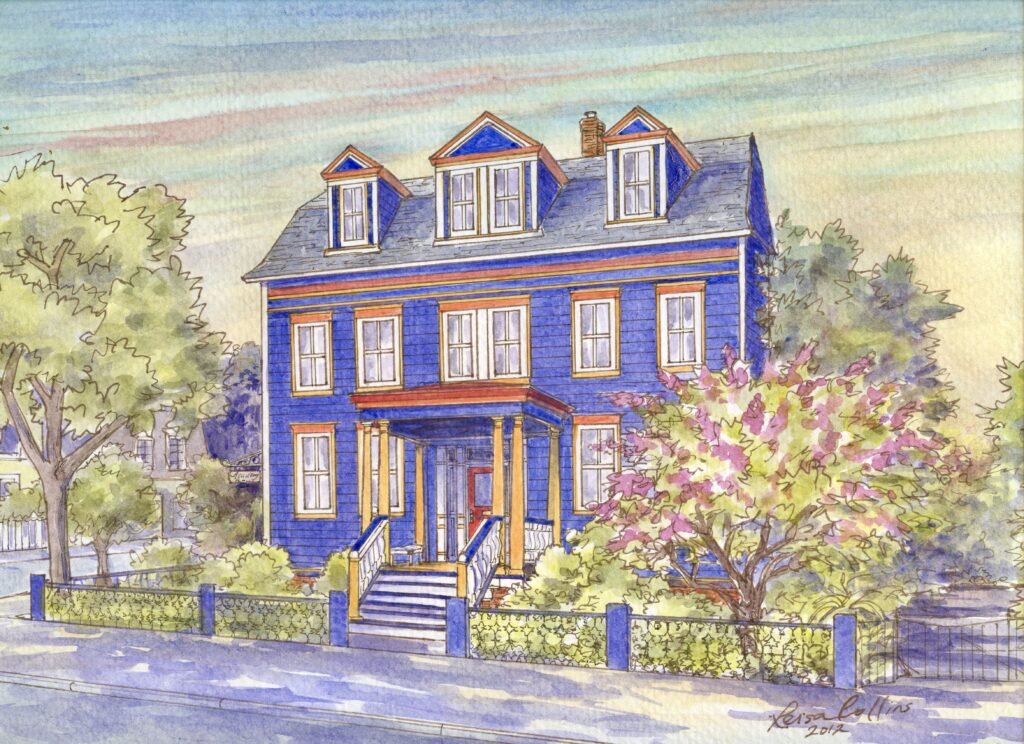Beautiful Bed & Breakfast in Annapolis, Maryland, makes Great House Portrait Subject!
I am continuing to add to my Annapolis Maryland historic house portrait series and this classic Dutch Colonial Revival caught my eye. Well it would be hard to miss it! Situated just one block from the famous Annapolis City Dock and the Naval Academy, the Academy Bed & Breakfast is right in the heart of the Annapolis Downtown Historic District. Just a few years ago the building was run down and delapidated. The current owners lovingly restored the building — both inside and out — to its former glory. I take my hat of to them. Doing a pen and watercolor painting of their lovely creation was the easy part!

I love downtown historical Annapolis. Here’s a little bit more information about the place.
From its earliest days as a colonial capital city, Annapolis was known as the “Athens of America.” The small seaport brought visitors from around the world who shared the news of the day while enjoying the ambiance and tidewater cuisine of the local pubs. You will find the same atmosphere today, drawing more than 4 millions people a year to its shores.
The capital of Maryland was originally called “Providence” when settled by the Puritans. It was later called “Anne Arundel’s Towne” after the wife of Lord Baltimore, who owned the proprietary colony. It wasn’t until a Royal Governor, Sir Francis Nicholson, moved the capital here from St. Mary’s City that the small seaport received its present name. Sir Francis chose to honor Princess Anne, heir to the throne. In 1708, as Queen, she chartered her colonial namesake as a city. Her royal badge, with a crown over the entwined thistle of Scotland and Tudor rose of England, is depicted on the Annapolis flag.
Sir Francis designed a city with a baroque plan similar to the capitals of Europe. He drew circles with radiating streets to create focal points and give importance to certain structures. In one circle is St Anne’s, the Episcopal Church, regarded as the spiritual center of the city. As the Church of England, it was originally supported by taxpayers. In the other circle, rising over the harbor, is the State House, the seat of government.
A thriving shipping industry brought great wealth to Annapolis and reflected in the quality of life. Prosperous merchants and “planters” sought to duplicate the amenities of their homeland in the colonies, and built mansions that would rival any in England. These homes, which entertained many of our Founding Fathers, had ballrooms and formal gardens where lavish social functions occurred.
Today, Annapolis has more of these original 18th century structures standing than any other city in the United States. Many are open to the public.
The arts abounded in colonial Annapolis, as performers, skilled artisans, and artists practiced their trades here and you will fine the same appreciation for the cultural arts in Annapolis today. Maryland Hall for the Creative Arts is a thriving center for studying, exhibiting, performing, and practicing the arts. Resident companies include the ballet, symphony, opera, and chorale who all give performances in its 800 seat auditorium. It is also home to resident artists who teach and maintain studios there and frequently exhibit in the galleries on the premises.
Annapolis has great historical significance for other reasons. The capital of Maryland was the country’s capital when the Treaty of Paris, ending the Revolutionary War, was signed here. All four Maryland signers of the Declaration of Independence had impressive homes in Annapolis, which still stand today.
Until my next post, Leisa


